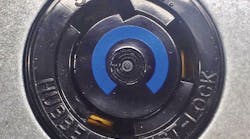I have asked hundreds of electricians, inspectors, and Code enthusiasts if the receptacle in the photo is included in the 2017 GFCI protection requirements of Sec. 210.8(B). I was surprised at the amount of confusion it presented.
Let’s try to figure it out by asking some questions. Is it a single-phase receptacle? Yes. Then, so far, it’s included. Is it 50A or less? Yes, it is rated 30A. Is it rated 150V to ground, or less? Ah, this is when the confusion starts to set it. If we install this receptacle on a typical 120/240V single-phase system, the voltage to ground would read 120V. It would then seem as though this receptacle should be bound by 210.8(B) rules. But should it be? The product listing information for receptacles indicates that these 250V devices are “tested on circuits involving a nominal potential to ground of 125V.” This also seems to imply that this receptacle may need to be included in 210.8(B) requirements. But what is the real voltage rating of the receptacle? The only voltage rating on this receptacle is 250V. There is no neutral conductor terminal on the receptacle. It is not rated 125/250V; therefore, it is not included in the literal wording as written in 210.8(B) because its voltage rating is 250V. If this was a receptacle with a neutral connection and a voltage rating of 125/250V, it would be included in the receptacles described in 210.8(B), since the receptacle’s voltage rating to ground would be 125V.
I believe the confusion happens because of the circuits that this receptacle is likely to be used on would typically have a nominal rating of 208Y/120V or 120/240V, but the wording in 210.8(B) makes no mention of the circuit voltage. It only mentions the receptacle voltage. The wording in 210.8(B) states, “all single-phase receptacles rated 150V to ground or less, 50A or less and 3-phase receptacles rated 150V to ground or less, 100A or less” installed in 10 specified locations shall have GFCI protection for personnel. Perhaps the intent of the rule is, in fact, to include this receptacle. Unfortunately, the literal wording combined with the typical uses for these receptacles are causing some confusion. You may need to have a discussion with your AHJ about this one. One thing I know for sure is the rule does include straight-blade receptacles as well as twist-lock and pin-and-sleeve type receptacles.





